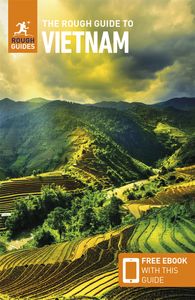Maps
The most accurate and reliable map of Vietnam is the Rough Guides Map of Vietnam, Laos and Cambodia (1:1,200,000). Other decent maps are the International Travel Map of Vietnam (1:1,000,000) or Nelles (1:1,500,000) map of Vietnam, Laos and Cambodia: both feature plans of Ho Chi Minh City and Hanoi. Alternatively, the locally produced maps you’ll find on sale in all the major towns and tourist destinations in Vietnam aren’t bad.
If you need more detailed coverage, if you’re cycling or motorbike touring for example, there’s no beating the book of maps entitled Giao Thong Duong Bo Vietnam (1:500,000) published by Ban Do Cartographic Publishing House and available in bigger bookshops in Hanoi and Ho Chi Minh City. Trouble is, it weighs about a kilo. Another good option for cyclists and bikers is the Vietnam Administrative Atlas by the same publisher, with a map of each province per page. Look out, too, for Fauna and Flora International’s Vietnam Ecotourism Map (1:1,000,000). Not only is it pretty accurate, but also includes information on visiting the national parks and other areas of environmental interest.
Money
Vietnam’s unit of currency is the dong, which you’ll see abbreviated as “đ”, “d” or “VND” after an amount. Notes come in denominations of 500đ, 1000đ, 2000đ, 5000đ, 10,000đ, 20,000đ, 50,000đ, 100,000đ, 200,000đ and 500,000đ, coins in 200đ, 500đ, 1000đ, 2000đ and 5000đ (though coins are rarely seen). In addition to the dong, the American dollar operates as a parallel, unofficial currency and it’s a good idea to carry some dollars as a back-up to pay large bills. On the whole, though, it’s more convenient to operate in dong, and you’ll often find dong prices are slightly lower than the equivalent in dollars. For the latest exchange rates go to xe.com.
Dong are not available outside Vietnam at present, so take in some small-denomination American dollars to use until you reach a bank or ATM. Most banks and exchange bureaux don’t charge for changing foreign currency into dong; banks in major cities will accept euros and other major currencies, but elsewhere may only accept dollars. Some tour agents and hotels will also change money, and most jewellery shops in Vietnam will exchange dollars at a slightly better rate than the banks, but watch out for scams. Wherever you change money, ask for a mix of denominations (in remote places, bigger bills can be hard to split), and refuse really tatty banknotes, as you’ll have difficulty getting anyone else to accept them.
There’s also a comprehensive network of ATMs, many open 24 hours: most accept Visa, MasterCard and American Express cards issued abroad. The maximum withdrawal is two million dong at a time, with a charge per transaction (in addition to whatever surcharges your own bank levies). In Hanoi and Ho Chi Minh City you’ll also find ATMs operated by ANZ and HSBC. These accept a wider range of cards, including those in the Cirrus and Plus networks.
Opening hours
Basic hours of business are 7.30–11.30am and 1.30–4.30pm, though after lunch nothing really gets going again before 2pm. The standard closing day for offices is Sunday, and many now also close on Saturdays, including most state-run banks and government offices.
Most banks tend to work Monday to Friday 8–11.30am and 1–4pm, though some stay open later in the afternoon or may forego a lunch break. In tourist centres you’ll even find branches open evenings and weekends. Post offices keep much longer hours, in general staying open from 6.30am through to 9pm with no closing day. Some sub-post offices work shorter hours and close at weekends.
Shops and markets open seven days a week and in theory keep going all day, though in practice most stallholders and many private shopkeepers will take a siesta. Shops mostly stay open late into the evenings, perhaps until 8pm or beyond in the big cities.
Museums tend to close one day a week, generally on Mondays, and their core opening hours are 8–11am and 2–4pm. Temples and pagodas occasionally close for lunch but are otherwise open all week and don’t close until late evening.
Phones
Mobile phones are as ubiquitous in Vietnam as they are everywhere else. However, transport centres like airports and bus stations still maintain a few functioning landline booths, which accept only pre-paid phone cards, not coins. All post offices also operate a public phone service, where the cost is displayed as you speak and you pay the cashier afterwards. Local calls are easy to make and are often free, though you may be charged a small fee for the service if, for example, you use the phone in a hotel lobby.
Mobile phones
If you want to use your own mobile phone in Vietnam, the simplest – and cheapest – thing to do is to buy a SIM card and a prepaid phone card locally (or even a phone, if your own is locked). Both the big phone companies, Vinaphone and Mobifone, offer English-language support and similar prices, though Vinaphone perhaps has the edge for geographical coverage (which extends pretty much nationwide).
The other, far more expensive, option is to stick with your home service-provider – though you’ll need to check beforehand whether they offer international roaming services.
















